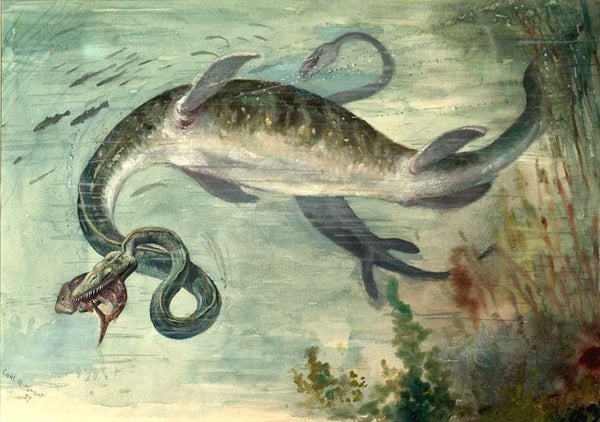This article was published in Scientific American’s former blog network and reflects the views of the author, not necessarily those of Scientific American
I grew up with noodle-necked plesiosaurs. In undersea depictions by artists like Charles R. Knight and Zdeněk Burian that were common in the fossil books I’d check out from my elementary school library, the ancient marine reptiles were so flexible that they could have tied themselves in knots if they wanted to. These Mesozoic monsters could comfortably sit at the surface or conceal themselves in silty gloom, whipping their necks out to snatch unwary fish with their needle-toothed jaws.
Floppy plesiosaurs have been out of style for a few decades now. Even though there hasn’t been a Plesiosaur Renaissance to match the dinosaur equivalent of the late 20th century, expert anatomists have nevertheless given plesiosaurs stiffer, straight necks that operated in coordination with the rest of the body rather than as independent, snaky appendages that could dart one way while the body was moving another. But this has only raised new questions, ranging from how long-necked plesiosaurs were able to catch their food to how a ludicrously-proportioned animal like Elasmosaurus could manage to swim away quickly from predators without giving itself a literal pain in the neck. The answer requires a rethink of how these famous marine reptiles behaved.
There’s nothing quite like a long-necked plesiosaur alive today. This, paleontologist Leslie Noè and coauthors point out in a new study on the marine reptiles, has confounded anatomists from the beginning. Plesiosaur necks just seemed far too long to be plausible, and this may have been a factor in why 19th century paleontologist E.D. Cope infamously placed the head of Elasmosaurus on the wrong end of the animal in his initial description. But even with the anatomy relatively straightened out, why such necks would evolve was a puzzle.
There’s been no shortage of explanations for how such bodies came to be. Some experts, Noè and coauthors review, thought that such long necks had no real adaptive value or were just holdovers from earlier ancestors. But this isn’t a satisfying explanation for features that carried biological and mechanical costs, not to mention that long-necked plesiosarus persisted from the group’s origin to their extinction at the end of the Cretaceous. On the other hand – or is that flipper? – behaviors like signaling to other members of the species and being able to breathe from the surface while submerged were possibly in the plesiosaur repertoire, but were unlikely to drive the evolution of the extreme feature. Most popular of all, of course, is “prey capture above or below the air-water interface”, but the relative stiffness of the plesiosaur neck would have prevented these animals from keeping their bodies still while lashing their necks around to nab fish and squid.
.jpg?w=600)
The skeleton and neck vertebrae of Muraenosaurus. Credit: Noè et al. 2017
To investigate the Mesozoic mystery, Noè and colleagues examined the long-necked plesiosaurs Muraenosaurus, Cryptoclidus, and Tricleidus. All three lived during the Jurassic, between 166 and 157 million years ago, in seas now preserved in the vicinity of Peterborough, England. All three had roughly triangular heads and jaws densely-packed with curved, spike-like teeth – a grin suited for nabbing food and swallowing the morsels whole. As far as their necks are concerned though, plesiosaurs were not nearly as flexible as historically portrayed.
Based on the articulations of the many, many vertebrate in the plesiosaur neck, Noè and coauthors found that “the range of movement available to the plesiosaur neck was strictly limited.” The oceangoing reptiles didn’t have much side-to-side flexibility at all, nor was there much room for movement in the dorsal plane. In other words, no swinging the neck out sideways to grab fish or rearing back into a swan-like S pose. But these same animals would have been able to dip their necks down easily, and this fits with previously-collected clues to their ancient diets.
While not necessarily the rule for all plesiosaurs, gut contents from two Cretaceous species found in Australia indicated plesiosaurs fed on bottom-dwelling crustaceans. Paired with the anatomy of the skull and teeth, Noè and colleagues suggest, these findings might mean that long-necked plesiosaurs operated as strange, sieve-feeding reptiles. They weren’t exactly saurian whales – interlocking teeth aren’t as good as baleen for filtering – but plesiosaurs probably dipped their heads to trap shoaling fish from the water column or scoop crustaceans from the bottom, sand and silt filtering out of their jaws.
On supporting science journalism
If you're enjoying this article, consider supporting our award-winning journalism by subscribing. By purchasing a subscription you are helping to ensure the future of impactful stories about the discoveries and ideas shaping our world today.

Not sad. Just swimming. "Lifestyle strategies in plesiosaurs." Credit: Noè et al. 2017
Plesiosaurs were more than necks, of course. Organisms have to be considered as a whole. In doing so, Noè and coauthors have underscored various interpretations of plesiosaurs over time into a new, integrated model – jaws suited for straining on the end of necks that could bend downwards, but were otherwise rigid enough to allow for rapid swimming. Taken together, these features transform plesiosaurs from Mesozoic weirdos to symbols of evolutionary success. “Our work suggests that the neck was a key evolutionary novelty” among plesiosaurs from their earliest days, Noè and colleagues conclude, allowing these fantastic creatures a long-lived history in the prehistoric seas.
Reference:
Noè, L., Taylor, M., Gómez-Pérez, M. 2017. An integrated approach to understanding the role of the long neck in plesiosaurs. Acta Palaeontologica Polonica. doi: 10.4202/app.00334.2016
